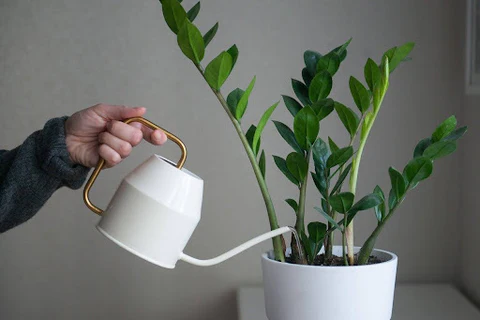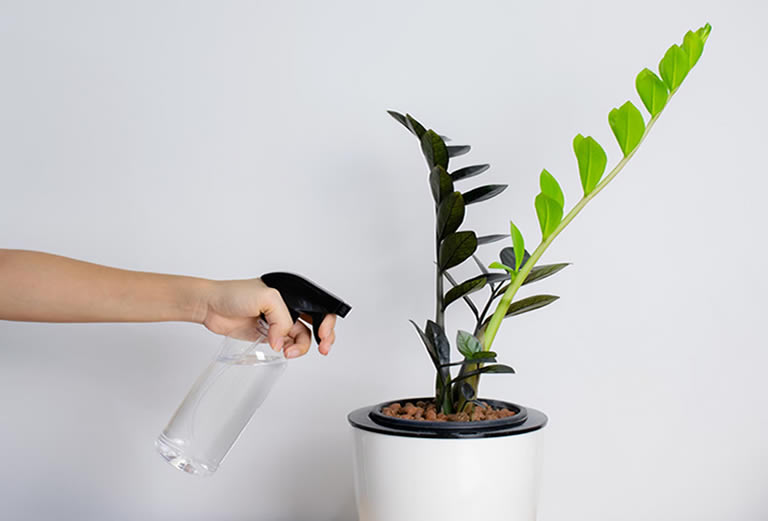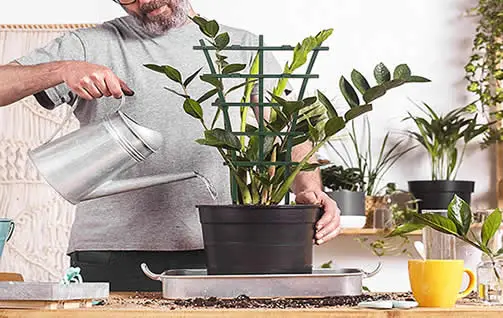The ZZ plant (Zamioculcas zamiifolia) is a fantastic low-maintenance houseplant that thrives with minimal care. One of the biggest mistakes plant owners make is improper watering. But don’t worry—if you follow this simple watering guide, your ZZ plant will stay happy and healthy, even if you occasionally forget about it!
Table of Contents
Z Plant Watering Guide: How to Get It Right Every Time
How to Water a ZZ Plant
✅ Wait until the soil is almost completely dry before watering.
✅ Water thoroughly until excess water drains from the bottom of the pot.
✅ Avoid watering on a set schedule—instead, check your plant regularly to see when it actually needs water.
While ZZ plants are extremely forgiving, they do not tolerate overwatering. Too much moisture can lead to root rot and other ZZ plant problems. Keep reading, and I’ll walk you through exactly how to perfect your ZZ plant’s watering routine!
The Most Important Thing About ZZ Plant Watering
ZZ plants are often called the “thrivers of neglect” because they can survive with limited light and water.
However, their biggest enemy is an over-attentive gardener who overwaters them.
It’s natural to want to nurture your indoor plants, but one common mistake is giving them too much water. For ZZ plants, this can quickly lead to root rot and eventually cause the plant to die.
To keep your ZZ plant healthy, follow these simple watering guidelines, and you’ll keep it thriving!
How to Tell When Your ZZ Plant Needs Water
Instead of watering your ZZ plant on a set schedule, it’s best to assess its needs based on the actual condition of the plant.
Here’s how I check when mine needs water:
- Finger test: Stick your finger about 2 inches into the soil. If it feels moist, the plant doesn’t need watering.
- Drainage hole check: Lift the pot and feel through the drainage holes. If the soil is dry or just slightly damp, it’s time to water.
- Leaf check: Drooping leaves with brown edges or widespread leaf drop means your plant is probably underwatered. On the other hand, yellowing leaves can signal overwatering.
- Chopstick or skewer test: Poke a chopstick or skewer all the way to the bottom of the pot, then pull it out and check if it’s damp. If the stick is wet with soil stuck to it, you can skip watering.
- Weight check: Dry soil is much lighter than wet soil. Get into the habit of lifting the pot every time you check, and soon you’ll be able to tell when it needs water just by the weight.
- Moisture meter: If you prefer something more high-tech, a moisture meter is a super affordable and handy tool. Stick it in the soil for a moisture reading, which usually ranges from 1 to 10.
Remember, ZZ plants have some succulent-like characteristics. They store water in their rhizomes, which are bulb-like structures under the soil.
These rhizomes slowly release moisture as needed, so your ZZ plant doesn’t require frequent watering like other houseplants.
By following these simple tips, you’ll keep your ZZ plant healthy without worrying about over or underwatering!

How Much Water Should You Use for Your ZZ Plant?
You might wonder if ZZ plants need just a little water each time to avoid overwatering. The answer is no—when you water your ZZ plant, it’s important to water thoroughly each time. Saturating the entire potting mix helps wash away excess mineral salts that could build up and harm the plant. Plus, it ensures the roots get enough moisture during each watering.
Here’s how I water mine:
- I take my plant to the sink to water it, ensuring it’s easier to let excess water drain out.
- I pour enough water to make sure it flows freely from the drainage holes at the bottom of the pot.
- Potting soil often behaves like a sponge. When it’s dry, it can repel water until it’s fully soaked. So, I start by adding a little water and let the soil absorb it for a few seconds. Then, I add more water and repeat this process.
- Once the soil is fully absorbed and moist throughout, I water freely until I see the water draining.
- I let the pot sit in the sink for a few minutes to drain completely before returning it to its spot.
How to Prevent Overwatering Risks
For anyone concerned that this technique could lead to overwatering, here’s a solution:
- Choose a porous pot that allows excess water to escape quickly.
- Use well-draining potting soil to avoid waterlogged roots.
- Select a pot that’s not excessively large, which helps the soil dry out at a healthy pace.
By following these steps, you can ensure your ZZ plant gets the proper amount of water without risking overwatering!
Factors That Affect ZZ Plant Watering
Now that you know how to check when your ZZ plant needs water and the best way to water it, it’s important to understand that several factors can influence how often you’ll need to water your plant. These factors play a big role in determining how quickly the soil dries out and how much moisture your ZZ plant needs.
Here are some key things to consider:
- Light levels: The more light your ZZ plant gets, the more water it will likely need. Plants in brighter spots will grow faster (this is a great way to make your ZZ plant grow faster) and use up moisture quicker than those in low-light areas.
- Temperature: Warmer temperatures mean faster evaporation and quicker drying of the soil. In contrast, cooler environments may slow down the drying process, so you won’t need to water as often.
- Humidity: ZZ plants do well in average humidity, but in a dry environment, the soil will dry out faster, requiring more frequent watering.
- Pot size and material: Larger pots hold more soil and moisture, meaning the plant may need watering less often. The material of the pot (like ceramic or plastic) can also affect how quickly the soil dries. Porous pots like terracotta allow moisture to evaporate faster, so they might need watering more often.
- Season: ZZ plants naturally grow slower in winter, so they need less water during the colder months. During their active growing season in spring and summer, they’ll need more frequent watering.
Other Factors Include:


